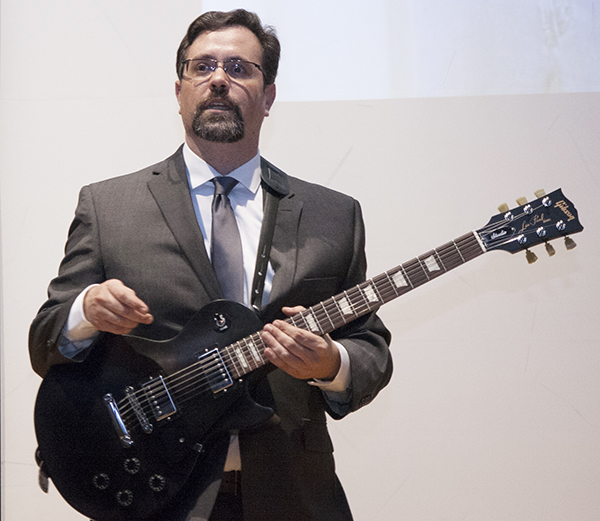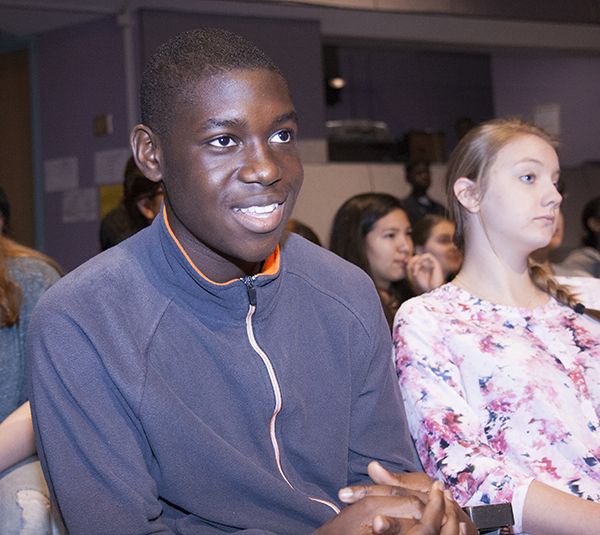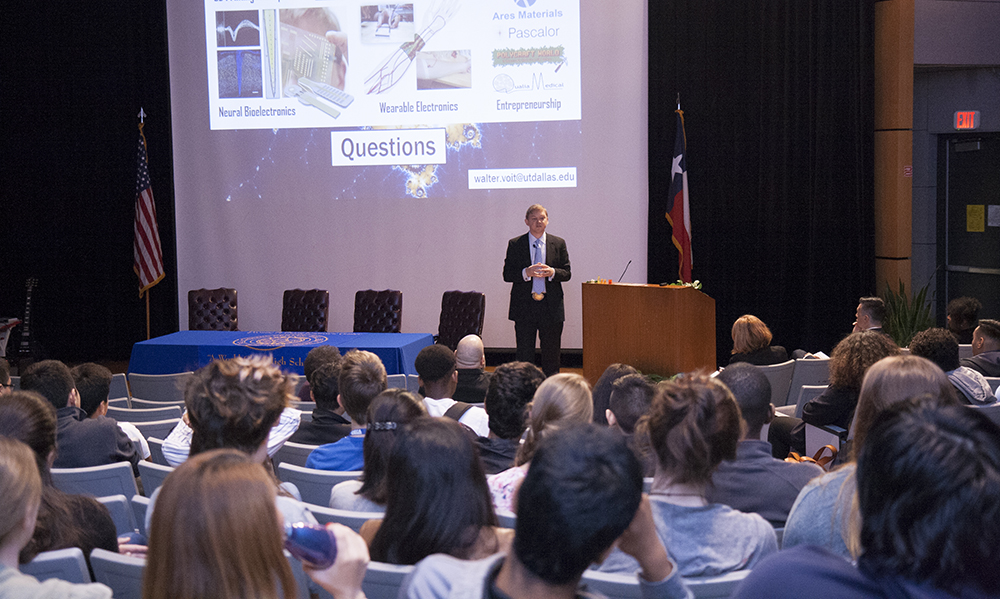
Dr. Russell Stoneback, assistant professor of physics, performs on his prototype of a “light guitar” that translates resonances in light waves into sound.
Engineering and physics faculty members from The University of Texas at Dallas recently showed area high school students how their interest in STEM fields can translate into academic research and entrepreneurial opportunities.
Rafael Martín, interim vice president for research at UT Dallas, introduced Dr. Walter Voit BS'05, MS'06, associate professor of mechanical engineering and materials science and engineering, and Dr. Russell Stoneback MS’06, PhD’09, assistant professor of physics, who talked about their research during the 14th Annual Math & Science Lecture Series at Yvonne A. Ewell Townview Magnet Center.
The center houses six magnet high schools in the Dallas Independent School District, including the School for the Talented and Gifted.
Voit, who was a McDermott Scholar, earned a bachelor’s degree in computer science and a master’s in artificial intelligence from UT Dallas before receiving a PhD in materials science from Georgia Institute of Technology. He explained his research in flexible electronics and told students why he combined science with the popular video game “Minecraft.”
Stoneback earned a master’s degree and PhD in physics at UT Dallas. He shared his work on space weather as a researcher at the University’s William B. Hanson Center for Space Sciences. He also presented his first public performance on a “light guitar” he developed that translates resonances in light waves into sound.
The annual lecture series, hosted by U.S. Rep. Eddie Bernice Johnson, D-Dallas, was created as a partnership with UT Dallas to promote career opportunities in science, technology, engineering and mathematics fields.
Johnson represents the 30th Congressional District of Texas and is the ranking member of the U.S. House Committee on Science, Space, and Technology. She was participating in a vote on health care in Washington, D.C., and an associate read her prepared remarks.
“Paradigm shifts in the ways the world’s economy works means the type of workforce we need to compete as a country has changed,” said K.L. Newhouse, director of outreach for Johnson’s office, as she read the congresswoman’s statement.

Kodjo Habia, 14, a freshman in the Magnet School for the Talented and Gifted, said the science presentations by UT Dallas faculty members were “pretty cool.”
“I want to make sure that the next generation is exposed to the kinds of jobs that are out there at the frontiers of human knowledge. These are the jobs of today, and I want you to at least consider exploring these STEM disciplines.”
Using slides and demonstrations with 3-D printed objects, Voit described several startup companies he’s launched, including one using flexible electronics to develop medical devices that may one day help control diabetes and obesity, and treat conditions like hypertension, rheumatoid arthritis and post-traumatic stress disorder.
“We’re building computer chips onto these shape-changing plastics. We can implant these plastics into the nervous system while they’re still stiff and rigid. When they get into the body, they get thousands of times softer and don’t cause scarring,” Voit said. “We’re doing some of the underlying science that’s going to change how health care works.”
Students’ hands shot up in the auditorium when Voit asked if anyone plays the “fun and addictive” video game “Minecraft,” which draws 100 million daily users.
“What makes ‘Minecraft’ so much fun?” Voit asked. “Video game designers spend a lot of time trying to captivate our attention. How can we embrace some of the things that video games do so well and begin integrating them into education so you guys can have fun learning?”
He then explained how the free mod he and his colleagues developed, called “Polycraft World,” has been downloaded by tens of thousands of gamers who teach themselves science and engineering concepts such as thermoplastic processing and petrochemical refining in order to build jetpacks, flame throwers and scuba gear.
“We’ve found ways to take what makes ‘Minecraft’ fun, and make it just a little bit more fun if you become a good scientist,” Voit said.
Stoneback shared slides from NASA to explain his research using satellites and ground-based instruments to study the Earth’s magnetic field and the ionosphere, which is the upper part of the Earth’s atmosphere. He described progress in the last few decades from orbiting instruments that UT Dallas designed in the 1990s for the Defense Meteorological Satellite Program to today’s much smaller and more efficient date-collecting devices that fit on a small CubeSat spacecraft.
“This spacecraft is about a foot long, 8 inches wide and 4 inches deep. So we went from bus-sized in the early ’90s to a spacecraft that I could literally hold right here in front of you,” Stoneback said.
“I’m hoping to get a lot more of these CubeSat instruments up into space, because for anything weather-related, it’s very complicated and you need a lot of measurements,” he said.
Stoneback, who played in a jam band while an undergraduate at UT Austin, drew applause when he showed students his prototype of a light guitar, and then played a few riffs using an audio plug-in that processes the sound. The science underlying the light guitar is very similar to the physics he’s exploring in the upper atmosphere.
Students had pointed questions for both Voit and Stoneback, including whether the biomedical devices being shown were on the market or still being tested.
“By the time you are in the workforce, this will be the standard of care,” Voit said.
Kodjo Habia, 14, a freshman in the Magnet School for the Talented and Gifted, thought the light guitar demonstration was “pretty cool,” despite his initial reservations.
“I have to say that when I heard you had a light guitar, I thought it was absurd,” Habia said. “Did your colleagues ever think your research ideas were weird?”
“Absolutely,” Stoneback said. “People definitely think I’m crazy sometimes.”
